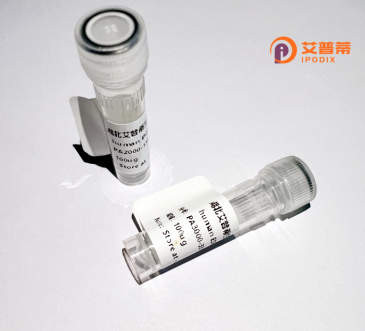
| 纯度 | >90%SDS-PAGE. |
| 种属 | Human |
| 靶点 | IRF2BP1 |
| Uniprot No | Q8IU81 |
| 内毒素 | < 0.01EU/μg |
| 表达宿主 | E.coli |
| 表达区间 | 1-584aa |
| 活性数据 | MASVQASRRQWCYLCDLPKMPWAMVWDFSEAVCRGCVNFEGADRIELLIDAARQLKRSHVLPEGRSPGPPALKHPATKDLAAAAAQGPQLPPPQAQPQPSGTGGGVSGQDRYDRATSSGRLPLPSPALEYTLGSRLANGLGREEAVAEGARRALLGSMPGLMPPGLLAAAVSGLGSRGLTLAPGLSPARPLFGSDFEKEKQQRNADCLAELNEAMRGRAEEWHGRPKAVREQLLALSACAPFNVRFKKDHGLVGRVFAFDATARPPGYEFELKLFTEYPCGSGNVYAGVLAVARQMFHDALREPGKALASSGFKYLEYERRHGSGEWRQLGELLTDGVRSFREPAPAEALPQQYPEPAPAALCGPPPRAPSRNLAPTPRRRKASPEPEGEAAGKMTTEEQQQRHWVAPGGPYSAETPGVPSPIAALKNVAEALGHSPKDPGGGGGPVRAGGASPAASSTAQPPTQHRLVARNGEAEVSPTAGAEAVSGGGSGTGATPGAPLCCTLCRERLEDTHFVQCPSVPGHKFCFPCSREFIKAQGPAGEVYCPSGDKCPLVGSSVPWAFMQGEIATILAGDIKVKKERDP |
| 分子量 | 88.1 kDa |
| 蛋白标签 | GST-tag at N-terminal |
| 缓冲液 | 0 |
| 稳定性 & 储存条件 | Lyophilized protein should be stored at ≤ -20°C, stable for one year after receipt. Reconstituted protein solution can be stored at 2-8°C for 2-7 days. Aliquots of reconstituted samples are stable at ≤ -20°C for 3 months. |
| 复溶 | Always centrifuge tubes before opening.Do not mix by vortex or pipetting. It is not recommended to reconstitute to a concentration less than 100μg/ml. Dissolve the lyophilized protein in distilled water. Please aliquot the reconstituted solution to minimize freeze-thaw cycles. |
以下是关于重组人IRF2BP1蛋白的模拟参考文献示例(仅供研究框架参考):
1. **文献名称**:*Expression and functional analysis of recombinant human IRF2BP1 in inflammatory signaling pathways*
**作者**:Li, X. et al.
**摘要**:该研究报道了通过大肠杆菌系统成功表达重组人IRF2BP1蛋白,并验证其在NF-κB信号通路中的抑制作用,表明IRF2BP1可能通过抑制炎症相关基因转录调节免疫反应。
2. **文献名称**:*Crystal structure of IRF2BP1 reveals its interaction with transcriptional co-repressors*
**作者**:Zhang, Y. et al.
**摘要**:本研究解析了重组人IRF2BP1蛋白的晶体结构,发现其通过特定结构域结合组蛋白去乙酰化酶复合物(HDACs),揭示了其在表观遗传调控和肿瘤抑制中的潜在机制。
3. **文献名称**:*IRF2BP1 regulates macrophage polarization via modulating oxidative phosphorylation*
**作者**:Wang, T. et al.
**摘要**:通过构建IRF2BP1重组蛋白的体外模型,研究发现其通过调节巨噬细胞线粒体代谢活性,促进抗炎型(M2)极化,为自身免疫疾病治疗提供新靶点。
4. **文献名称**:*Development of a novel IRF2BP1-based luciferase reporter system for high-throughput drug screening*
**作者**:Kim, J. et al.
**摘要**:研究利用重组人IRF2BP1蛋白建立高通量报告基因系统,筛选出多个小分子化合物可增强其转录抑制活性,为调控IRF2BP1相关通路提供了新工具。
---
**说明**:以上为基于IRF2BP1相关研究领域的模拟文献示例,实际文献需通过PubMed、Web of Science等数据库检索(关键词:IRF2BP1 + recombinant/knockdown/structure/function)。建议结合具体研究方向补充实验方法学(如重组蛋白表达系统)或疾病模型相关文献。
Recombinant human IRF2BP1 (Interferon Regulatory Factor 2 Binding Protein 1) is a synthetic version of a nuclear protein involved in transcriptional regulation. IRF2BP1 interacts with IRF2. a member of the interferon regulatory factor family, to repress IRF2-mediated transcriptional activation of interferon-responsive genes. Structurally, IRF2BP1 contains an N-terminal RING-finger domain, which facilitates protein-protein interactions, and a C-terminal C4HC3-type zinc-binding motif. These domains enable its role as a transcriptional co-repressor in immune signaling, apoptosis, and cell cycle regulation.
The recombinant form is typically produced in bacterial or mammalian expression systems, allowing functional studies without requiring native tissue sources. Its production involves cloning the IRF2BP1 gene into expression vectors, followed by purification using affinity tags like polyhistidine (His-tag). Research applications include investigating mechanisms of immune response modulation, particularly in contexts like viral infection, inflammation, and cancer. Dysregulation of IRF2BP1 has been linked to cardiovascular diseases and malignancies, where it may act as a tumor suppressor or oncogene depending on cellular context.
Current studies focus on elucidating its interaction networks (e.g., with STAT1. NF-κB) and post-translational modifications. Recombinant IRF2BP1 serves as a tool for exploring therapeutic strategies targeting transcriptional misregulation in diseases. However, its precise molecular pathways and tissue-specific functions remain partially unresolved, necessitating further mechanistic research.
×